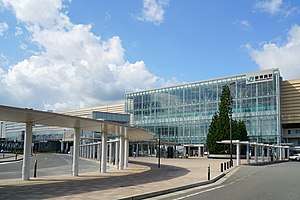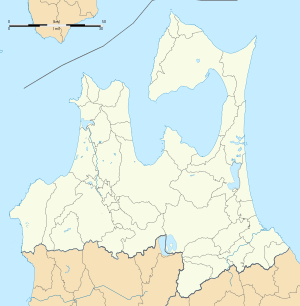Shin-Aomori Station
Shin-Aomori Station (新青森駅, Shin-Aomori-eki) is a railway station in the city of Aomori, Aomori Prefecture, Japan, operated by the East Japan Railway Company (JR East).
Shin-Aomori Station 新青森駅 | ||||||||||||||||||||||||||||||||||||||
|---|---|---|---|---|---|---|---|---|---|---|---|---|---|---|---|---|---|---|---|---|---|---|---|---|---|---|---|---|---|---|---|---|---|---|---|---|---|---|
 The east entrance in September 2014 | ||||||||||||||||||||||||||||||||||||||
| Location | Ishie, Aomori-shi, Aomori-ken 038-0003 Japan | |||||||||||||||||||||||||||||||||||||
| Coordinates | 40°49′39″N 140°41′36.5″E | |||||||||||||||||||||||||||||||||||||
| Operated by |
| |||||||||||||||||||||||||||||||||||||
| Line(s) | ||||||||||||||||||||||||||||||||||||||
| Distance | 713.7 kilometers from Tokyo | |||||||||||||||||||||||||||||||||||||
| Platforms | 3 island platforms | |||||||||||||||||||||||||||||||||||||
| Tracks | 6 | |||||||||||||||||||||||||||||||||||||
| Connections | Bus stop | |||||||||||||||||||||||||||||||||||||
| Other information | ||||||||||||||||||||||||||||||||||||||
| Status | Staffed (Midori no Madoguchi) | |||||||||||||||||||||||||||||||||||||
| Website | Official website | |||||||||||||||||||||||||||||||||||||
| History | ||||||||||||||||||||||||||||||||||||||
| Opened | 1 November 1986 | |||||||||||||||||||||||||||||||||||||
| Rebuilt | 2010 | |||||||||||||||||||||||||||||||||||||
| Traffic | ||||||||||||||||||||||||||||||||||||||
| Passengers (FY2016) | 7,652 daily | |||||||||||||||||||||||||||||||||||||
| Services | ||||||||||||||||||||||||||||||||||||||
| ||||||||||||||||||||||||||||||||||||||
| Location | ||||||||||||||||||||||||||||||||||||||
 Shin-Aomori Station Location within Aomori Prefecture  Shin-Aomori Station Shin-Aomori Station (Japan) | ||||||||||||||||||||||||||||||||||||||
Lines
Shin-Aomori Station is the northern terminus of the Ōu Main Line from Fukushima via Akita (a distance of 486.3 km (302.2 mi)), although most trains continue on to Aomori. It also forms the northern terminus of the high-speed Tōhoku Shinkansen line from Tokyo (a distance of 674.0 km (418.8 mi)), operated by JR East, and the starting point of the Hokkaido Shinkansen to Shin-Hakodate-Hokuto (a distance of 148.9 km (92.5 mi)), operated by JR Hokkaido.
Station layout
The conventional Ōu Main Line has a single island platform, serving two tracks. In addition to regular Ōu Main Line trains, the station serves two round-trips per day of Aoimori Railway trains, as well two round-trips of the irregular Resort Asunaro (direct to Noheji and the Ōminato Line). Upon the opening of the Tōhoku Shinkansen extension on 4 December 2010, the station became the southern terminus of Hakuchō Limited express services to Hakodate via the Tsugaru Kaikyō Line, which ceased upon commencement of the Hokkaidō Shinkansen in March 2016.
The Shinkansen portion of the station, opened on 4 December 2010, consists of two elevated island platforms serving four tracks. The platforms are 263 meters long and capable of handling 10-car trains.[1] The station has a Midori no Madoguchi staffed ticket office.
Previously, Shin-Aomori Station was an unmanned station consisting of a single side platform for bi-directional traffic.
Platforms
| 1 | ■ Ōu Main Line | for Aomori |
| 2 | ■ Ōu Main Line | for Hirosaki and Akita |
| 11,12 | ■ Tōhoku Shinkansen | for Hachinohe, Morioka, Sendai, and Tokyo |
| 13,14 | ■ Hokkaido Shinkansen | for Shin-Hakodate-Hokuto |
History
Shin-Aomori Station opened on 1 November 1986 as a station on the Japanese National Railways (JNR). With the privatization of JNR on 1 April 1987, it came under the operational control of JR East. Work on a new station building began in July 2007, and was completed in 2010 ahead of the opening of the Tōhoku Shinkansen extension on 4 December.
The Hokkaido Shinkansen to Shin-Hakodate-Hokuto opened on 26 March 2016, and is being extended to Sapporo, due to open in 2031. Shinkansen services replaced the former Hakucho and Super Hakucho limited express services from March 2016.
Passenger statistics
In fiscal 2016, the conventional portion station was used by an average of 3,619 passengers daily (boarding passengers only) and the Shinkansen portion by 4,033 passengers.[2][3] The passenger figures for previous years are as shown below.
| Fiscal year | Daily average | Total | |
|---|---|---|---|
| (Conventional) | (Shinkansen) | ||
| 2010 | 1,083[4] | - | 1,083 |
| 2011 | 2,730[5] | - | 2,730 |
| 2012 | 3,319[6] | 4,571[7] | 7,890 |
| 2013 | 3,639[8] | 4,523[9] | 8,162 |
Surrounding area

- Aomori-Nishi High School
- Shinjo Elementary School
- Galatown Aomori West Mall
- Aomori Kenko Land
See also
- List of Railway Stations in Japan
References
- Misawa, Manabu (January 2010). 東北新幹線・九州新幹線 建設状況最新レポート. Tetsudō Daiya Jōhō Magazine. Vol. 39 no. 309. Japan: Kōtsū Shimbun. pp. 29–35.
- 各駅の乗車人員 (2016年度) [Station passenger figures (Fiscal 2016)] (in Japanese). Japan: East Japan Railway Company. 2017. Retrieved 1 January 2018.
- 新幹線駅別乗車人員 (2016年度) [Shinkansen passenger figures (Fiscal 2016)] (in Japanese). Japan: East Japan Railway Company. 2017. Retrieved 1 January 2018.
- 各駅の乗車人員 (2010年度) [Station passenger figures (Fiscal 2010)] (in Japanese). Japan: East Japan Railway Company. 2011. Retrieved 15 February 2015.
- 各駅の乗車人員 (2011年度) [Station passenger figures (Fiscal 2011)] (in Japanese). Japan: East Japan Railway Company. 2012. Retrieved 15 February 2015.
- 各駅の乗車人員 (2012年度) [Station passenger figures (Fiscal 2012)] (in Japanese). Japan: East Japan Railway Company. 2013. Retrieved 15 February 2015.
- 新幹線駅別乗車人員 (2012年度) [Shinkansen passenger figures (Fiscal 2012)] (in Japanese). Japan: East Japan Railway Company. 2013. Retrieved 15 February 2015.
- 各駅の乗車人員 (2013年度) [Station passenger figures (Fiscal 2013)] (in Japanese). Japan: East Japan Railway Company. 2014. Retrieved 15 February 2015.
- 新幹線駅別乗車人員 (2013年度) [Shinkansen passenger figures (Fiscal 2013)] (in Japanese). Japan: East Japan Railway Company. 2014. Retrieved 15 February 2015.
External links
| Wikimedia Commons has media related to Shin-Aomori Station. |
- Official website (in Japanese)